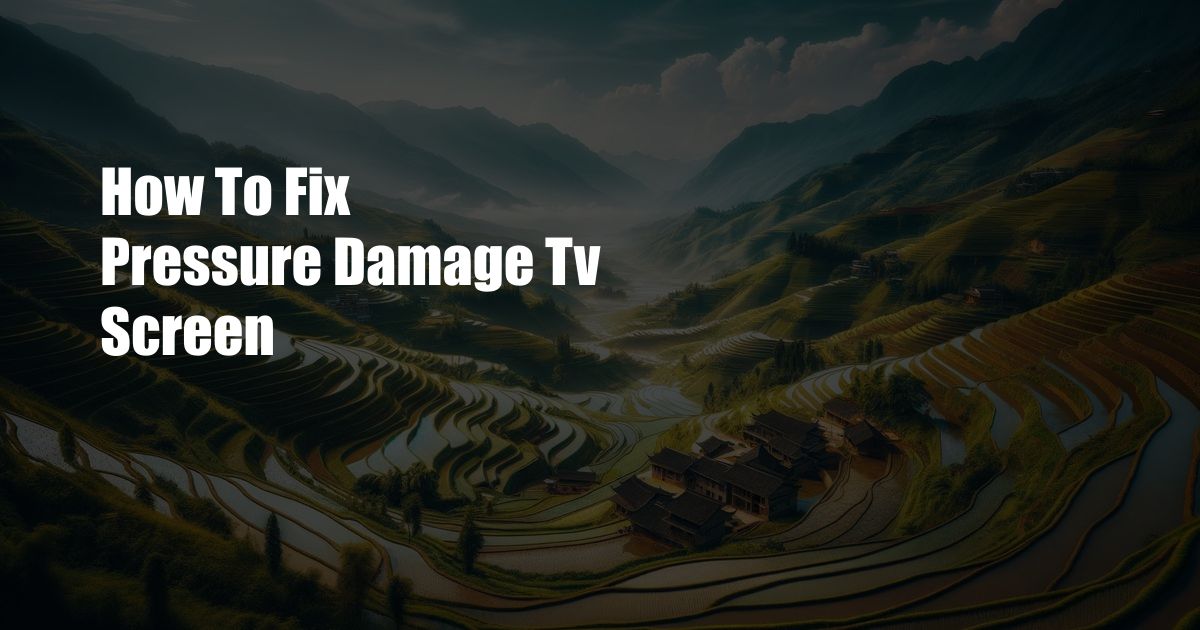
How to Fix a Pressure Damaged TV Screen: A Comprehensive Guide
I was watching my favorite show when tragedy struck. My rambunctious toddler tripped and crashed into the TV, sending a wave of pressure down the screen. In the aftermath, I was left with a shattered, distorted mess. But instead of panicking, I knew there were steps I could take to fix it.
Pressure Damage: A Silent Killer for TV Screens
Pressure damage occurs when excessive force is applied to a TV screen, leading to broken pixels and distorted images. The severity of the damage varies depending on the force and type of impact. Liquid Crystal Display (LCD) screens are particularly vulnerable to pressure damage as the liquid crystals can easily shift and misalign.
Understanding the Anatomy of a Damaged TV Screen
To understand how to fix a pressure damaged TV screen, it’s crucial to know its anatomy. Behind the protective glass, you’ll find the LCD panel, which houses the liquid crystals. When an electrical current passes through the crystals, they align or scatter, allowing light to reach or block pixels, creating the vibrant images you see.
DIY vs. Professional Repairs: Making an Informed Decision
Depending on the severity of the damage, it’s possible to repair a pressure damaged TV screen yourself. However, it requires specialized tools, knowledge, and a steady hand. If the damage is substantial, it’s highly recommended to seek professional assistance to avoid further complications.
Step-by-Step Guide to Fixing a Pressure Damaged TV Screen
1. Safety First:
Before attempting any repair, unplug the TV and ensure it’s completely discharged. Wear gloves to avoid fingerprints and smudges on the delicate screen.
2. Assess the Damage:
Inspect the screen for cracks, lines, and distortions. Note the affected areas and their size to determine the extent of the repair.
3. Gather Your Tools:
You’ll need:
- A clean microfiber cloth
- A suction cup (optional)
- Liquid crystal repair fluid (only if the damage is minimal)
- High-quality clear tape (if DIY repair)
- Electrical tape (if DIY repair)
4. DIY Repair (Minimal Damage):
- Gently dab the repair fluid onto the damaged area using a microfiber cloth.
- Avoid applying excessive pressure.
- Allow the fluid to penetrate for 15-20 minutes.
- Use a suction cup to gently lift the damaged area and press it back into place.
- Secure the lifted area with high-quality clear tape, making sure to press firmly around the edges.
5. Professional Repair:
If the damage is significant, it’s best to seek professional assistance. Trained technicians can:
- Replace the LCD panel if necessary
- Realign the liquid crystals
- Restore the screen’s functionality
Tips and Expert Advice
- Always use a microfiber cloth when cleaning or repairing the screen to prevent scratches.
- Avoid putting pressure on the screen when lifting it or placing it back into the frame.
- If you’re not comfortable with DIY repairs, don’t hesitate to contact a professional.
- Consider investing in a TV screen protector to prevent future damage.
FAQs on Pressure Damaged TV Screens
Q: Can I fix all types of pressure damage on my TV screen?
A: Minor pressure damage can sometimes be repaired using DIY methods. However, severe damage requires professional attention.
Q: How can I prevent pressure damage on my TV screen?
A: Handle your TV with care, avoid placing heavy objects on it, and secure it firmly to a stable surface.
Conclusion
Fixing a pressure damaged TV screen requires a combination of patience, precision, and the right approach. By following the steps outlined above and seeking professional assistance when necessary, you can restore your beloved TV to its former glory. Remember, every pixel matters, so handle your TV with care to avoid the heartbreak of a shattered screen.
Are you ready to tackle the challenge of fixing a pressure damaged TV screen? Let us know in the comments below!
 Azdikamal.com Trusted Information and Education News Media
Azdikamal.com Trusted Information and Education News Media